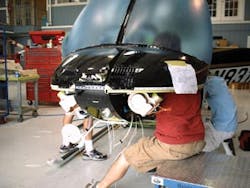What goes up must come down, is an age old adage that we in aviation hold particularly sacred. The come down part is generally best suited when it is in line with the intentions of the flight crew.
Adaptation of the gyroscope to aviation is considered by many to be the single most important event that has allowed our industry to progress, and throughout the years inertial information has been used to provide flight crews with the data necessary to safely maneuver aircraft through the atmosphere. A close second to the gyro could very well be the advances in navigation. With the implementation of precisely positioned earth orbiting satellites many other forms of radio navigation and even sophisticated compass systems have for all practical purposes become obsolete.
Adding a helicopter
Suppose one day your boss comes in and says, “We want to add another single engine helicopter. Go find one adequate to do the job.” So what are the first steps, of course after ordering an additional supply of stress medicine?
Definition of the primary mission along with available funding can often provide key guidelines. Another factor is timeline. If the boss wants to place the machine in service within six months and the lead time for a new aircraft is a year and a half then options become somewhat limited. When perusing the pre-owned market despite what the salesman or broker says, these are still used aircraft. They were configured to satisfy someone else’s mission and questions regarding previous operation and maintenance should be addressed. Ideally finding a seller with a similar profile and circumstance can provide the easiest transition.
As with any aircraft transaction, a thorough review of records including flight logs can provide an accurate indication of how the aircraft will operate as well as enable future owners to anticipate upcoming expenses.
First candidate
One of the first candidates that I encountered looked like it had it all. The price was a bit high but still within the guidelines depending on what else would need to be accomplished. There were about 600 flight hours recorded in the logs and for an eight-year-old aircraft it appeared a bit underutilized. Perhaps that’s why it was being sold. As I delved into the specifications list it became apparent the current owner liked gadgets. It had it all including auto-pilot and weather radar. Eventually I reached the weight and balance documents and turned up an interesting fact. It seems that if the aircraft were to take off with a full load of fuel it could carry the pilot and one half of a passenger. Unfortunately the only way this machine would fit the mission would be to remove most of the bells and whistles.
Second and third prospects
The next prospect was a police force retiree with a mere 13,000 hours time in service. While it wasn’t pretty inside or out, it did have several things in its favor. First the price was right and secondly the maintenance history was impeccable. Even the instrument panel had all the essentials and a few of the wish list items. The police decommissioning process had removed about 500 pounds of specialized equipment including wiring. While in the planning process to initiate this aircraft into its new life my cell phone rang and it was the sales representative who had advised me earlier of the 18-month lead time for a new aircraft. He had word of a customer who had a new aircraft scheduled for delivery within two weeks and would be willing to sell it.
A review of the equipment list produced an image of a Spartan helicopter. The flight instruments consisted of a magnetic compass, inclinometer, altimeter, and an airspeed indicator.
Mission considerations
It was obvious that supplemental equipment would have to be added but considering the limitations at hand what would provide the most bang for the buck? It was decided that mission considerations would provide the insight as to what instrumentation would be included.
Standard operation would be conducted in daylight under Visual Flight Rule (VFR) considerations. Mission profiles will include personnel transport, sightseeing, cattle herding, and predator management with most operation in remote areas including coastal plains. Some of the local hazards include telecommunication towers, power lines and rapidly changing weather conditions and it will periodically operate on cross country flights utilizing FAA controlled airports and airspace. One of the primary concerns is the rapid loss of the VFR situation which leads to the onset of inadvertent Instrument Flight Rules (IFR).
It was determined that an adequate defense against IFR would be an array of appropriate panel mounted situational displays including an electric Attitude Indicator, Directional Gyro and a Vertical Speed Indicator. A mode S transponder would be installed to make the aircraft visible to Air Traffic Controllers as well as other aircraft equipped with Traffic Collision Avoidance Systems (TCAS).
Taking into account the area in which the rotorcraft was to operate most frequently has relatively few radio navigation aids, it was a logical decision that an Automatic Direction Finder (ADF) and even a Very High Frequency (VHF) navigation radio would be underutilized and not pulling their own weight, therefore they would not be installed, plus a single engine helicopter spending most of its life operating in and out of cow fields was hardly a candidate for a sophisticated and expensive instrument landing system.
Satellite navigation was the most logical choice and dual global positioning systems (GPS) became part of the package. Taking into account weight and space constraints it was decided to go with a combined GPS/VHF communication radio. This would satisfy the redundancy factor in both the navigation and communication categories. A portable GPS with panel mount capability and an XM radio receiver was selected to be the other navigation source.
Modern navigation devices often have the ability to combine numerous features in a small package. In addition to being able to obtain and present global positioning data, many newer units can display airport diagrams and even terrestrial information such as the position of communications towers and routing of power lines.
XM radio is well known for delivering entertainment programming but is also a means of providing weather information including Next Generation Radar (NEXRAD), Aviation Routine Weather Reports (METARs [French translation]), Terminal Aerodrome Forecasts (TAFs), Temporary Flight Restrictions (TFRs), Lightning and Winds Aloft and can be laid directly over the topographic map databases. Availability of weather information like XM Radio entertainment is available through a subscription service provided by several providers. Many current GPS products either come with or have the ability to add a street map data base. This feature can be a tremendous asset when the pilot requires assistance in an IFR (I Follow Roads) situation.
Installations
The installation of this equipment will require positioning the display in an area that is easily viewed by the pilot. In some cases portable units can be fitted into an instrument panel but rarely without some type of panel modification. Installation location should take into account travel of the cyclic and collective controls along with the effects of the sun on the display in various aspects of flight.
Determining antenna locations in helicopters can be another challenge. Many newer aircraft make extensive use of composite materials so proper electrical bonding and ground planes may not provide the most desirable results. Systems that utilize a “line of sight” transmission may encounter issues where the main rotor could partially block the antenna resulting in loss of the radio signal under certain flight conditions such as when a station is behind the aircraft. A communication antenna located at the bottom of the ship is generally less effective while the machine is on the ground. In fact we decided to locate the primary communications (comm.) antenna on top of the machine while the second antenna was installed on the belly.
A separate radio was installed to allow communications with the various ranch hands. In this case a Very High Frequency (VHF) model was procured and the output power was adjusted as prescribed by Federal Communications Commission policy. The antenna in this case was installed on the tail boom fairing. The consideration here is that radio utilization will be in a “close in” condition with ground personnel within a one- to two-mile range.
The audio and intercom systems were areas that required significant thought and planning. The pilot has two VHF communication radios to manage plus a ranch radio. In addition there is the XM receiver that among other things can provide news, weather, sports, and both Country and Western music.
Probably the most important aspect of an audio/intercom system is the ability for the pilot to communicate with the passengers and more important, on VIP flights, for the passengers to be able to talk to the pilot. It was already determined that noise-canceling headsets would be standard issue for all passengers. The pilot however would utilize a standard headset so he could pay more attention to the surroundings including audio warnings and detection of any unusual noises.
Adding electronic equipment to an avionics rack or instrument panel will also require an evaluation of available ventilation and cooling air. In this case taking into account the machine would be operating during the summer months in an environment where temperatures of 100 F are common place it was decided to first of all install a large capacity Freon air conditioner for both pilot and passengers along with an additional cooling fan dedicated to the electronic equipment installed in the instrument panel. A unit receiving direct current (DC) electrical power was selected. This decision was also based on the fact that the fan motor actually operated on alternating current (AC) produced by a converter unit installed within the blower. That meant reduced maintenance due to the lack of commutator brushes.
Once all the antennas and other optional equipment are installed, the aircraft is scheduled to go in for custom paint. This is another area that has the potential to create problems. Discounting the obvious one where the boss hates the appearance, another concern is the impact paint can have on the machine’s ability to discharge stray electrical charges. In this case a corona discharge test is planned prior to paint so any defects can be corrected and then a high voltage check will be accomplished after the paint is applied to ensure consistent static discharge capability.
Well, it appears this project has been defined and planned. Everything appears to be on schedule and within the budget guidelines and there was no need for any stress medication. When the boss was advised that the new helicopter deployment would occur as planned, his comment was “Great, now you can start working on the outfitting of the new corporate jet we just bought.”
Jim Sparks has been in aviation for 30 years and is a licensed A&P. His career began in general aviation as a mechanic, electrician, and avionics technician. Currently when not writing for AMT, he is the manager of aviation maintenance for a private company with a fleet including light single engine aircraft, helicopters, and several types of business jets.
About the Author

Jim Sparks
Jim Sparks has been maintaining aircraft for almost 40 years with the majority of the time involving Business Aviation activities. Jim’s endeavors have placed him on six of the seven continents contending with numerous situations from routine flight dispatch to critical AOGs. His career includes maintainer, avionics/electrician, educator, tech rep, and director of aircraft maintenance. In addition to other activities he is engaged with ASTM assisting in the global development of criteria defining the Next Tech for NEXTGEN. You can reach him at [email protected].
